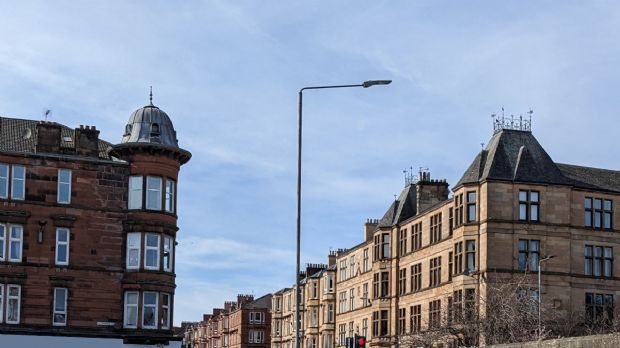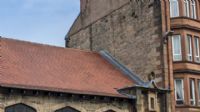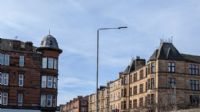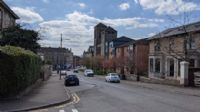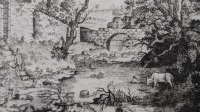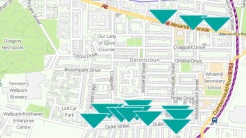The Evolution of the Glasgow Tenement
Glasgow 1860
In 1860 the City Officials scheduled for clearance the historical centre of the city. This should not be interpreted as an indication of buildings that had become obsolete and unused but rather that it illustrates the progressive zeal in which they embraced their work. It can be readily proven that for a number of decades such demolition succeeded in not only displacing the problem but also exacerbating it by further increasing demand on existing housing stock. The sudden demand for housing, which accompanied industrialisation and population growth, from 77,385 in 1801 to 784,496 in 1901, was met almost entirely by private rented dwellings.
From 1862 the sanitary authorities ticketed congested houses to indicate the maximum occupancy. Writing in 1869, William Holms tells of inspections carried out on these houses and cites from one instance where a house ticketed at 1643.5, in this case the number indicating the cubic capacity of the house and the number of adults (5) legally allowed to occupy the house:
It contained seven adults and seven children, most of them lying on the floor; the excuse made for this overcrowding was, that the lodgers were people who had been turned out of their houses owing to the formation of the Union Railway; and being unable to get accommodation elsewhere at a suitable rent, had taken one of the two apartments in this wretched building.
The position of housing in Glasgow at this point is also characterised by the vast differences of accommodation available at the time. However it is important to consider that in the middle of the nineteenth century over half the people in Scotland lived in houses consisting of only one or two rooms. From 1600 to about 1850, most people in cities and burghs lived in small houses. Dwellings of one or two rooms were the norm for working people and for many in the 'middle ranks'. The more ancient areas of the city, chiefly from the River Clyde in the south of the City, via Briggait, Saltmarket and High Street to the Cathedral, were a mixture of 16th to 18th century formerly middle class houses. These areas had long fallen prey to the restless nature of the mobile merchants and artisans that they had once contained. Conditions in these buildings and the attendant housing or back lands that had sprung up on the open spaces to their rears, are well documented in other accounts such as the works by Shadow. Such living conditions are captured in the candid descriptions of night time visits on these abodes.
Life in The Streets, Wynds, and Dens
Written in 1858 by Thomas Murray under the pseudonym 'Shadow' Midnight Scenes And Social Photographs - Sketches of Life in The Streets, Wynds, and Dens of the City of Glasgow describes night time forays into the closes and vennels of the overcrowded parts of the City and describes the conditions found and of the occupants of these houses:
Visiting a close in Saltmarket they follow a plain but respectable looking man up a narrow filthy close, as we enter, we are forcibly struck with the remarkable appearance of the domicile, and a group of half dressed people of both sexes cowered around the fireplace; it is small, ill lighted and worse ventilated, in a corner is a window, near the roof, just enough to grudgingly illuminate a prison cell in an obscure part of the abode is a large filthy pail, apparently the urinal common to the entire household.
Such works however were often the product of middle class reformers using sensationalism to highlight the plight of their fellow citizens. Accordingly less sensational, the insights into the newly emerged middle class living at this point can be gleaned only from such varied sources as furniture inventories published for roup or auction in the local press and the detailed family portraits taken which include room views. In addition to this, the periodic references in literature are often the only sources of illustration of conditions for the better off citizens of Glasgow at this point.
The middle class perspective of these accounts is evident in the expressions of immorality and personal weakness as the source of these peoples misery. 'Shadow' describes many visitations on abodes often expressing disdain at the impropriety of the occupants by virtue of the proximity of strangers as lodgers in houses, in partial undress and in mixed sex company. Further extending remark to offer an explanation at the cause of the social evils "to deny in the face of overwhelming authority, that intemperance is not a cause of this depravity, would be absurd".
Sanitary Inspector
Other commentaries, however, posited different and more objective stances. Giving evidence to the Royal Commission in 1917 with reference to the inspection of ticketed houses, Peter Fyffe, the Sanitary Inspector in Glasgow, declared it a degrading thing to have any family living under conditions where they are apt to be stirred up at any time during the night by men coming in with lanterns and books and taking notes. Extending his evidence in highlighting the difficulties in obtaining true representations of the number of occupants in houses to be inspected he further comments that:
In some streets in Glasgow they are so friendly with one and other, that, whenever the night men appear at one end of the street the word passes round right through the street, and by the time they get to the closes further on, the inmates have all got up and are dressed. Sometimes the people have got into presses, into barrels, and into enclosed places above the bed - sometimes on the roof, hiding behind the chimney head.
Typically, early seventeenth century tenement buildings would have housed a wide social mix of people. The gentry and middle ranks occupying the best rooms on the first and second floors while trades' people and craft workers occupied the less convenient flats and poorest people had garrets and cellars. However, by the middle of the nineteenth century these properties had mostly been 'made down' whereby a number of households were created from what had previously been one. Lamenting after these properties, Dr. James Russell, successor to the City's first Medical Officer, Dr. William Gairdner, appointed in 1856, protested that:
Almost without exception these ticketed houses are what we call 'made down houses'. No plans of these houses were ever submitted to the Dean of Guild Court. They may be either, as in the older parts of the city, in tenements erected long before the Police Act of 1866, for the gentry of old Glasgow, or in tenements which have passed the court recently as houses of 5, 8 or 10 rooms. In short, these houses have all been parts of houses of larger size; often parts of single rooms of houses of larger size, divided by partitions sometimes of mere wood, run across the floor of those large rooms. This means defective ventilation, defective light, dark lobbies [hallways], crowded stairs, and disproportion in the conveniences provided.
By the end of the 1860s the Medical Officer of Health was trying to ensure that water was available on the stair head at least on every second floor of tenements and that there should be one water tap to ten families at minimum. As these were for common use they would be located at the end of corridors to a window opening. This would allow the minimum disruption caused by the introduction of water supply pipes to the inside of the building and also allowing them to drain into the existing rainwater goods from the roof. There was also the concern that ineffective maintenance could often lead to water running down the stairs from leaking pipes and spillage and consequently the authorities discouraged introducing water directly into single ends and even two apartment houses. This situation would continue to influence the positioning of sanitation in flats and the creation of sculleries in later tenements of the nineteenth century, even after more effective sanitary fittings were available.
Typhus and Cholera Outbreaks
Whilst concern was levied at the implications of bad housing for the families forced to domicile in these abodes, there was a mounting body of evidence indicating that the periodic visitations of disease hit these areas more heavily than the less densely populated addresses. Commenting on typhus, Professor of Medicine at the University in 1840, Robert Cowan, identified the foul conditions in which people lived as the main cause of epidemic. "The total want of cleanliness", "the absence of ventilation", "the accumulation, for weeks or months together, of filth of every description in our public and private dunghills". The last great typhus outbreak occurred in 1869-70, after which the clearance of some of the worst housing coupled with a rigorous isolation and cleansing brought a dramatic reduction.
The periodic outbreaks of cholera in Glasgow were in tandem with the outbreaks elsewhere in Britain at the time. The first outbreak happening in 1832, the others in 1848-49, 1853-54 and 1866. Whilst the sporadic outbreaks of cholera conformed to those of other cities, the intensity and virulence in Glasgow resulted in more deaths directly from the disease than in any other city. Commenting on the outbreak of 1866, Dr. Russell bluntly explained the reason for the reduction in numbers in comparison to the previous outbreaks in Glasgow. That 'there was no essential difference in the places to which cholera led us in 1866 and those…in 1849; excepting that pure water abounded in the wynds and vennels'.
This last outbreak of cholera in 1866 is of particular interest. The newly laid suburb of Dennistoun was taking shape on the cities eastern side. As the actual mode of infection had not been isolated by this point and measures against the disease were based, incorrectly, on the miasmic theory of disease that spread by the transmission of noxious vapours. Dennistoun was located slightly east of some of the worst offending housing and the prevailing wind ensured a regular supply of air from the troubled parts of the old city.
The ability of the City to expand outwards and most significantly westwards provided more modern commodious abodes in less densely populated locales. In 1861, City Chamberlain John Strang was bemoaning the fact that the 'love of change, so inherently in the inhabitants' was inducing inner city residents to 'leave the older domiciles empty for others of a newer description'. Areas such as Laurieston on the south bank of the River Clyde and the Georgian developments at the westerly extremities of the city, such as Blythswood Hill and George Square had long provided a salubrious lure from the densities of the older areas of the city. However, whilst the expanding city centre increasingly encroached upon the older expansions into the countryside, the more affluent chose to move farther afield. As the nineteenth century progressed these migrations were to be further extended in areas such as Woodlands Hill and Hillhead in the west and Victoria Park in the south.
Alexander Dennistoun and James Salmon
Located less than one mile east of the High Street, Dennistoun was first proposed as a middle class suburb in 1854, when local landowner Alexander Dennistoun instructed James Salmon (1805-1888) to prepare a feuing plan for his property. Salmon's plan was one of the most ambitious and formalised among the many schemes yet devised in the Victorian suburbanization of Glasgow. Not one of the original plots was designated for tenements, indeed the corresponding advertisement for this scheme, which appeared three years later than the feuing design, described the developer's preference for 'self contained houses'. However, Peter Reed argues that the venture into the countryside around the city was the vision behind much Victorian suburbanization and the disadvantage of the east side location and the competition from the south and west soon prompted a revision in the feuing proposals. Whilst the grandeur of Dennistoun's original plans for his suburb had undergone some reduction in scale, the housing offered was at moderate rent and price although it was still intended for a comparatively affluent few.
Dennistoun provides a varied example of both skilled artisan and middle class housing. It also provides a convenient cross section of the variety and nature of tenement houses during the last half of the nineteenth century. It also illustrates the consequent buildings which arose due to different concerns in the private rented sector of the housing market until the First World War. Its earliest tenement houses dating from the mid 1860s on its western boundary and its latest pre-war building of 1910 on its eastern perimeter. Significantly the land was feud by the one family and their successive trustees. The Dennistouns themselves resided in Golfhill, the house itself surviving until the 1920s, located within the North West boundary of the area. Its location may have influenced the early development of the area, as the earlier tenements were located some distance from Golfhill House itself.
The earlier period of building in Dennistoun centred on the western boundaries of the estate. By the late 1860s several of the terraces of villas were complete and there was a concentration of larger tenements on Duke Street in the area called Kings Cross, the junction of Bellgrove Street at Duke Street. The increasing presence of the tenement buildings around the perimeter of the area and being surrounded by industrial settlements placed considerable pressure on the area's ability to sustain the venture into an exclusively suburban villa site. Thus by the 1870's the predominant buildings being erected were tenements.
Having considered some of the concerns of successive city officials at the evils, which seemed endemic in the more ancient parts of the city and the dangers of living there. It would fall upon the design of new tenements to ensure both the wellbeing of the occupants and a return on the capital expended in their erection.
Bathrooms and Water Closets
From plans inspected in a sample survey of Dennistoun tenements it was found that there is considerable detail listed as to the arrangement of both the layout and functions of the flats. This includes in most instances the appearance of the building, the mechanical construction of the building, the positioning of sanitation provisions and ventilation arrangements.
The indication of whether the back court is raised provides illustration of a mixture of land use with commercial or light industrial premises being located on the ground immediately to the rear of the building, thus requiring the back green to be located on its roof. This also resulted in the repositioning of drying greens to the roofs of tenements themselves in some instances, although Dennistoun contains no buildings of this type. In both occasions these would have been termed 'high backs' by the occupants.
The earliest plans still available for inspection are from September 1886 and the most recent from April 1910. The survey covers inspection of applications made for the erection of 130 buildings containing some 1034 dwelling houses. Of the buildings, only five list no provision for bathing whilst another two list the provision of houses with mixed arrangements and 79 flats with only the provision of a water closet. The earliest date of the properties with no bathroom is Jan 1897. The latest being April 1910 which was also the last tenement building to be erected on the site before World War 1. This would give the initial impression that the quality of the buildings had reached a peak in provisions and then a marked decline in the services provided, however, the nature of these provisions does still allow for the comparison of technical provision for lighting and ventilation.
Of all the bathrooms and water closets, not one of them was located in a position that was outside the door to the individual property and none of them were for common use. Some 540 had direct windows facing the rear of the property and 97 to the front. Significantly those having windows to the front of the building showed a high instance of being corner sited buildings where the constraints of the site often left the architect no option but to locate a window to the front, most preferences being to have only public and bedrooms facing the street. Some 11 had arrangements for light to the close itself, significantly here that in these few occasions the buildings were not fitted with a mechanical door entry system and all had stair head windows, thus allowing for a through put of fresh air, the absence of which having been much lamented at by the city officials of the 1860s. In the case of the remainder, 386 had arrangements for ventilation other than direct to the street or close. This could take the format of venting a bathroom over a scullery with the two rooms sharing the same window opening to either the front or rear of the building. This particular arrangement allowed for the restricted introduction of water goods to the houses and limited thus the possibility of water penetration to rooms other than for sanitary use.
Some had purpose built fresh air inlets for the bathrooms and a vent discharging the spent air through specific vents to the roof as opposed to above the scullery. Examples also of provision of a window between the bathroom and scullery, allowing borrowed light, although the air was provided directly from the outside. Also examples of houses with scullery and kitchen, both with rear facing windows. This provides the notion of containing the sanitary goods together and away from the main kitchen area where food would be prepared.
The importance of providing internal sanitation in the form of a bathroom or water closet, specifically for the use of one family, appears consistent in the buildings erected in Dennistoun throughout its tenement building period. Whilst the plans examined range only from 1885 upwards, the examination of buildings dating prior to this can be cited as evidence in consistency at least to the extent of sanitation being provided for each individual household. The plans submitted at various dates for the conversion of a range of ground floor flats to shops on Duke Street, provide an illustration of the lay out of buildings dated before 1885 and detail their existing layout at the point of alteration. An application for alteration, shows the layout as it was in 1893, with 8 bathrooms in the building all having windows to the rear of the property. Another three closes in the range show buildings on this occasion with light water closets to the rear and the latter building having only an internal water closet with no lighting or ventilation. None of these flats were built with sculleries of any description and would indicate both an earlier period of building by layout and an earlier standard of amenities. This would indicate that throughout the period, the importance of discrete toilet facilities remained a constant in the area, with every building containing at minimum an internal water closet although the facilities connected with the provision of fresh air, light and removal of spent air remained at variance.
Public Rooms and Bedrooms
The examination of the rooms listed as for public use according to the plans allows an indication of the class and wealth of the intended tenants. In Glasgow the historic provision of public rooms emerged during the latter half of the 18th century as the venue for significant social occasions. These were specifically within the domestic environment of the middle ranks and initially took the form of a dining room only. The use of the dining room, its table and significantly male drinking in the home provided for a vehicle for displays of wealth and allowed individuals to practice codes of civility which contributed to the allocation of status and prestige. From the survey, some twenty five buildings show more than one room for public use. The earliest flat listing the provision of two public rooms for which the data is available is dated 1886, and provide both the front elevation and plan of a neighbouring building of the following year. Significantly the larger of the public rooms is listed as the dining room and the lesser as a parlour, however the preference for three windows to the street for the parlour, has emerged by this point. It had previously been the custom to place only a single window on the parlour, this had extended to two by the 1870s and was further extended to three by the 1880s. This would continue to influence the placing of bay windows on parlours as the provision of a separate dining room fell from favour. The earliest of the flats with two public rooms also has two closed recesses for sleeping in addition to a bedroom. The preference for public rooms over bedrooms also coincides with the decline in size of middle class families, more marked after the 1870s. Public rooms with closed or open sleeping recesses were not generally built in Dennistoun after 1893 in any of the flats examined, the one exception being a corner building on Alexandra Parade from May 1902, which specifically lists an open recess to the parlour. Again the fact that this particular building is a corner sited one, indicates the ability to posit a detraction from the normal pattern which had established itself in the area.
Of the twenty five buildings with two public rooms, fifteen of them showed a variation of size within the same building, with twelve of them having only one bedroom in addition to the other rooms. Also, thirteen of the buildings were corner sited which would allow the architect some freedom in provision of rooms with windows facing the street, no public rooms were facing the rear courts in any occasion. It had been a previous fashion to locate in addition to a drawing and dining room, a small parlour to the rear, rooms permitting. Also with these buildings containing more than one public room, only eight showed the provision of a scullery, generally earlier nineteenth century flats did not provide this particular facility. The last building to be built with more than one public room was in June 1904, although this particular building provided as with its neighbours, accommodation of a particularly high standard. Its facing neighbour included the provision for the corner flats, of a fireplace in the hallway, immediately facing the front door as the flat was entered. The only other flat in the area to list a fireplace in the hall is the main door flat contained in a building also on Whitehill Street. Robert Lumsden petitioned both buildings with one designed by James Salmon.
Enriched Cornicing
There are however other considerations on this particular subject. The earliest plans, as mentioned previously, date from only 1885. This denies the close examination of large ranges of buildings dating from before this period; these were therefore physically examined on site.
The range of buildings on Roslea Drive all showed evidence of having two public rooms facing the street. All of these buildings were of white sandstone and the first two ranges mentioned all contained bay windows for the dining room. As a rule the provision of enriched cornice in the number of rooms facing the street indicated its intended use other than a bedroom. The dining room was frequently indicated, in addition to its location, by the nature of the enrichments in the cornice, containing fruit and vines, in addition the dining room was most often the larger of the public rooms and its door located immediately adjacent to the kitchen. Consequently bedrooms were provided only with plain cornicing which remained consistent throughout the later half of the century in all tenement flats.
The range of buildings on Roslea Drive between Armadale Street and Meadowpark Street, appear to date earlier than any of the buildings contained in the Drives, the block after Meadowpark Street on the south side of the Drive has a date stone showing 1876. The former range provide the only vista of tenement symmetry in all of Dennistoun, with the exception of one building on the north side of the street, which has its staircase located to the front of the building and has only one public room. This particular building attempts to carry the fenestration of its neighbours with the staircase occupying the centre windows. The building itself appears to be constructed in the smaller space left by the creation of its neighbours. This range is notable also for the distinct lack of bay windows, possibly harking after earlier periods of tenements buildings elsewhere in Glasgow, e.g. the pseudo Georgian frontage of Franklin Terrace in Finnieston (c.1850). The street elevation shows an arrangement indicating the dining room as the larger public room, which remained de rigour throughout the whole period of building flats with two public rooms. These blocks also indicate from their rear elevation, the provision of only a kitchen and bedroom, with the bathroom lit and vented to the close.
The Ubiquitous Bay Window
The range on the north side of Finlay Drive between Whitehill Street and Armadale Street also provide properties with two public rooms facing the street, again determined by the enriched cornicing present in the rooms, although by this point the ubiquitous bay window had established itself in regular uniformity. This range also contains internal stairwells with a cupola to the roof and upon inspection have no light closets to the closes.
Uniquely the corner building on Whitehill Street at Ingleby Drive is the only building in the survey area to list a public room as a drawing room and is further distinguishable by the use of a five turreted bay window on its corner. This particular building also lists a parlour in addition to the drawing room and marks the only departure from the dining room and parlour arrangement in the other larger flats, although its calibre conforms to the other buildings appearing towards the top of Whitehill Street at this time.
The significance to the provision of more than one public room in these flats can be related to the number of houses available to let at the time. If a builder or petitioner foresaw the potential to increase the size of the dwelling houses, accordingly the potential rental value for the property would increase. Balanced against this however, is the more intensive housing of fewer and smaller apartments that could yield a higher rental to the size of the feu. The last of the large flats built in Dennistoun were completed in 1905 and examination of the number of dwelling houses within Glasgow at the time shows a rapid rise of empty properties after 1904. The number of houses recorded as unoccupied in Glasgow during 1903 is 6,438, which jumped to 10,195 in the following year and peaked at 19,715 by 1910.
Unfortunately there is no separate record to indicate the instances where these properties were unoccupied due to their recent completion and thus awaiting the required 'drying out' period before the houses became habitable. Either way the evidence of a surfeit of housing at this point could sufficiently alter the rate and size of properties being built. Considering that they were still mostly speculative ventures at this point, the quantity and quality of housing built for lower middle class in both Glasgow and within Dennistoun, seemed to have reached its zenith with regard to number of public rooms. Another point to consider here is the financing of new buildings, which often were paid for by the sale of recently completed buildings in the same block. New buildings thus were susceptible to the demand and occupation of recently completed buildings and an inability to sell or rent out properties could considerably slow down the proposal and completion of new buildings. Indeed, the average small house builder existed on a precarious financial basis of loans or sale of ground annuals in addition to credit for materials. This compelled him to erect one tenement after another as quickly as possible during a building boom, in order to remain solvent.
The slowing down of housing demand could also account for the awkward gaps left in the drives, such as on the south side of Ingleby Drive between Whitehill Street and Armadale Street. This gap was utilised as allotments until the 1960s when local authority housing was erected on the site. Other gap sites such as Craigpark Drive between Whitehill Street and Cumbernauld Road remained unused until the 1930s when again the local authority stepped in and erected housing on these gaps. However the material in this range of buildings is of red stugged ashlar unlike its municipal contemporaries in the neighbouring estate of Haghill. This provides not too great a departure from at least the colour of the adjacent Victorian tenements, which are of red polished ashlar. This would also have considerably raised the cost of their erection and certainly could account for the necessity of the stugged finish, as polished ashlar would have made the cost prohibitive.
Natural Lighting and Ventilation
The use of cupular windows for the lighting of stairwells and landings (the stair could not take the more common form of a 'dog leg' stair, if the light was to reach the ground floor) remained in use throughout the period of building in Dennistoun. The first building for which the plans are available and those of the last both contain cupolas. There were attempts to ensure the regular supply of fresh air from the outside through the introduction of vents at floor level in the wall, which went to the rear wall of the building. There was clearly an awareness of the concerns raised by city officials at the capacity for closes to harbour disease when devoid of light and ventilation. This extended again to the reticence of placing light pantries or closets to closed wells when no stair head windows were available. The use of a cupola in the building erected on Golfhill Drive in 1904 can be readily explained by its proximity to the adjoining building, although from the plans, no special arrangement is apparent for the provision of ventilation other than the close opening at the front. All the other buildings having plans that contained cupolas were corner-sited buildings where the preferred stair head window posed particularly difficult to accommodate.
The provision of natural ventilation and lighting in the interior of the closes showed a consistent awareness by builders and architects to the wellbeing of the occupants. To the extent that where additional ventilation was not provided, no closets or presses were lit from borrowed light off the closes, and presses neither added to nor took from the possibly contaminated air from the stair. This awareness had earlier materialised in previous buildings in the area where the more typically Edinburgh arrangement, and for our purposes an endorsement of middle class exclusivity, whereby the entry into the close was by a door which was opened by lifting a lever located on the landing. The block on the north side of Roslea Drive between Whitehill Street and Armadale Street still have the levers for lifting the door latch and although also provided with stair head windows, have no lit presses to the close. Again a realisation of the limited air flow through the building. The blocks in the same position on Finlay Drive have no evidence of door entry systems in addition they have no visible additional ventilation in the close and are lit by cuppular windows.
The Buildings without Dean of Guild Plans
There are some buildings that can still be viewed but have no plans lodged in the city archives. This would immediately infer a date prior to 1885. The ranges of buildings on the north side of Duke Street after Hillfoot Street are constructed consistently of white polished ashlar. However the variety of size and complexity of lay out does allow some comparisons to be drawn from the buildings on the drives. For the first two blocks the three bay windows makes a regular appearance until the western corner at the bottom of Whitehill Street. This group of buildings is sadly missing their corner block, which was demolished in 1991, although the closes flanking the now vacant plot were part of the same construction. The remaining two buildings have a single window room that appears to be a parlour indicating a building date of circa 1875.
Proceeding along the street the next block presents a variety of different sized dwellings. Fortunately plans for alterations to four of these closes were submitted, when demand for retail space in the area pressed for the conversion of ground floor flats to shops. The earliest application available is dated December 1893 and lists the layout of the building as it was in use by the time of the proposed alterations. The plans show the flats to have only one public room with two bedrooms with a kitchen and bathroom facing the rear of the building. One of the windows is blank and its moulding serves only to allow a continuation of the fenestration. The other two submissions cover three buildings, D.O.G. 1890 and 1896. One set of plans proposing the introduction of an additional set of bay windows. These buildings all contained two public rooms fronting the street and two of them contained two bedrooms, the remainder only one. However none of them contained bathrooms, with only light water closets in two of the closes and one building having no visible means of lighting or ventilation for its water closets at the time of the proposals.
The following block on the north side of Duke Street between Armadale Street and Meadowpark Street appear to mirror the block described earlier. These have no bay windows in the entire block. The narrowness however, of the individual buildings implies only a bedroom and parlour to the street elevation. The next range follow a continuation of buildings of the same nature although they terminate on the corner and the next buildings which lead around the corner onto Cumbernauld Road indicate a severe reduction of standards from is neighbours. This continues around Cumbernauld Road and returns to a block on Roslea Drive that is dated 1876.
Unique to Dennistoun
On the north of Roslea Drive between Whitehill Street and Armadale Street, there is a range of white ashlar buildings, which contain a centrepiece. The two tenements in the centre of the block are one storey higher than the tenements that reach to and around the corner. This arrangement is unique in Dennistoun and in Glasgow rare if not non-existent. The lower buildings with only three storeys contain flats, which have both garrets and dormers in the roof. All this range have been fitted with mechanical door entry systems, have bathrooms venting and lit over the sculleries and have each two bedrooms, excepting the flats with additional dormers and garrets. Each building in this range has also two main door flats.
The range on the south of Finlay Drive between Whitehill Street and Armadale Street present somewhat of a discontinuity from the street. Although this range does not afford the continuity of its facing partner, the buildings exhibit two public rooms to the street with a kitchen, bathroom and bedroom to the rear.
Following along Finlay Drive present a diminutive version of the previous block. They contain a parlour and bedroom to the front with a light bathroom and kitchen only to the rear.
There is a block on the north of Garthland Drive between Whitehill Gardens and Meadowpark Street for which no plans are available. This white ashlar block contains, like its neighbours, two public rooms facing the street. The rapid growth of buildings in this area and the very sudden use of red ashlar on this drive could indicate the building to be by the same petitioner.
Ingleby Drive, commencing at Meadowpark Street alternates between having two public rooms and one public and one bedroom facing the street. Consequently a variety of three and two apartment flats, present a frontage that continues undisturbed for the block. These flats all have bathrooms and kitchens to the rear, with the larger flats having a bedroom located to the rear occupying the space broached from its smaller neighbour. None of these flats have visible sculleries.
The ranges on Onslow Drive commencing at Whitehill Street and on the north of the drive are all of white ashlar. One of the buildings is dated 1875 and the block indicated a parlour and bedroom to the front of the property with a kitchen and bathroom to the rear. Although nearing Armadale Street the irregularity of the close entrance infers a variety of different sized buildings. However, the block on the south of this drive suddenly shifts to very large red ashlar tenements. This could indicate that the completion of the south of this drive, as it was originally intended, was another victim of the depression following the City of Glasgow Bank crash. The difficulty with this particular block is the style, size and colour of the building itself, which accords to other buildings in the area of the late 1890s. The D.O.G. records which are still available commence in 1886 and the buildings being erected then were of white ashlar although red ashlar was being utilised on Finlay Drive but was not commonly used until later in that decade. No explanation is obvious as to why these buildings do not have D.O.G. applications available.
The Influence of the Architects
The designing of tenements was often carried out by the city's main architectural practices as one of their subsidiary activities. The contribution of these architects was also supplemented during a boom, by that of other small firms specialising in tenements.
The partnership of Frank Burnet, William Boston and James Carruthers were responsible for the planning of only two tenements on the north of Craigpark. This partnership had started in the office of John Carrick and consequently had extensive input to the activities of the CIT. These two tenements are of particular interest on two accounts. They are the closest to Golfhill House, erected in 1892 and named as Dalmeny Terrace. These were erected adjacent to the Dennistoun Baths (1883), and retained their open outlook until the building of the neighbouring tobacco factory in the 1930's, the surrounding land had been used for grazing until that point. The ground floor left flat of one tenement is unique in all of the flats in Dennistoun, being composed of two floors entered from the ground and first floor, with its own internal stair and having a full stair head window to the north gable. All other flats built over two levels were done so composing the top floor and garrets of the building. The site is also of interest due to another application to the D.O.G. for a range of buildings, which were never built.
W.G. Gardener formed a partnership with J. McKissack sometime after 1872 and produced only two tenements on Finlay Drive (1886). These two buildings are unusual in containing garret and dormer rooms in a conventional tenement of four storeys. All other tenements containing these types of rooms had been confined to buildings of three storeys aside from one solitary building on Duke Street. The building on Duke Street however, appears due to the number of flues in the west chimney head, to have been a later addition to the top storey. This partnership dissolved around 1890 and McKissack continued to produce several ranges of tenements between 1898 and 1904 for both William Anderson and William Miller. His work includes the last of the larger tenements in the area and he seems to have been particularly influential on Whitehill Street, although his work was not confined to larger properties, as his range on Meadowpark Street will testify.
James Salmon produced only two pieces of tenement work in Dennistoun, both centred around Whitehill Street. His input is particularly significant, as he had drawn up the original feuing plan for Dennistoun and indeed residing in the suburb himself. The calibre of his work on the five buildings he designed indicates his intentions of the area retaining its middle class nature. His planning of internal layouts was carefully thought out, as befitted one who prided himself on a knowledge of hygiene. His range on Whitehill Street was possibly one of his last pieces of tenement work, for although the Dean of Guild Court passed the plans in February 1889, he had infact died during the previous year. This captures one of the difficulties of working with material of this nature as only the date of authorisation is recorded, the planning and actual execution of works could span several years from conception to completion. His other piece of work is an outstanding corner tenement and its neighbour on the corner of Finlay Drive at Whitehill Street. This building lists on its north gable "Hawthorn Buildings 1887". As previously mentioned the ground floor flat of the corner building contains a fireplace in the hall which was only to be surpassed by Macwhannell and Rogerson's work of 1902 at the top of the same street.
John Thomson, son of Alexander (Greek) Thomson, paired with Robert Sandilands for partnership in 1886. Their work in Dennistoun is limited to just two tenements. Their work in Dennistoun is not characterised by any great significance although the innovative use of air intake vents to the bathrooms was being utilised in their buildings. The site itself appears to have lain unfeued, possibly as a consequence of the collapse of the City of Glasgow Bank in 1878, gauged by the abrupt end of the adjacent corner building, which is dated 1876.
Of the group of architects who specialised in the design of tenements, to the almost complete exclusion of everything else, George F. Boyd, a small one-man firm of this kind, produced a significant number of buildings in this area. From when he first went into practice in 1886 until 1901 with two large ranges of building comprising of three blocks: The western side of Hillfoot Street. The western side of Whitehill Street between Roslea and Finlay Drives and all the red coloured buildings in the block from Duke Street up the eastern side of Hillfoot Street, along Roslea Drive and starting back down Whitehill Street. These ranges of buildings are considerably smaller than those previously erected on Whitehill Street and generally compose of two room and kitchens with bathrooms venting over the sculleries.
The Legislation
The role of the City Officials during the last half of the nineteenth century gradually increased as the nature of local government across Britain also became extended. Its role in relation to housing in Glasgow was initially to attend to the worst of the slums, the usual response being purchase and demolition. This was intended to act as a catalyst in providing at public auctions, land at prices intended to stimulate alike the land market and local entrepreneurship in the building industry. In addition to embarking upon site clearances the municipal authority sought to appoint specific officials and lay prescriptive measures on the modification of existing and new buildings to be erected within the city boundary.
The Local Police Act of 1862 was used by a local committee to grant the deployment of temporary measures for a period of five years, in an attempt to curb the effects of some of the conditions in the most overcrowded parts of the city. This act also sanctioned the appointment of a medical officer of health. These temporary measures were however, made permanent in 1866. They recommended that all the ashes and night soil become the property of the city and also introduced the inspection of domestic dwelling houses with less than 2000 cubic feet, with a view to prevent overcrowding. In addition the 1866 Act established the City Improvement Trust, which provided for the buying and clearing of congested areas that were deemed hazardous to health. This was concerned mainly with the area around Glasgow Cross. Is has been argued that the motive force behind this early exercise in municipal socialism was middle class concern at the dangers the slums held for them. The 1866 Act also set up a Cleansing Department, which opened in 1868. The increasing legislation was a means to exercise control over the patterns of life for the slum dwellers.
Demolition of the worst offending houses began in the autumn of 1869 and by 1877 half the houses scheduled for demolition had been pulled down. New building at this point was however left almost entirely to private enterprise, albeit with strict regulations that properties should be no more than four storeys in height and have only one single apartment house on each level, the other houses being composed of two or three apartments. No municipal building took place before 1878, as private builders were ready to build on cleared sites.
City of Glasgow Bank
The collapse of the City of Glasgow Bank on 2 October 1878 had a particularly local impact. Many of the builders who had feued land from the Trust were declared bankrupt and building for some time came to a complete standstill. The slump in building activity was however symptomatic of a wider economic crisis although the building trade suffered particularly badly as a result of the recession, effectively bringing the work of the Trust to a halt for almost a decade. It ceased to demolish property and found itself the largest slum owner in Glasgow.
The 1880s was characterised by little activity either in the erection of new buildings or in the disposal of legislation affecting housing. From 1888 however, a more ambitious scheme of demolition and municipal building was embarked upon, but there was still no attempt to provide housing for the poorest classes. In 1889 the Health Committee demanded an end to privies in tenements and a new Police Act of 1890 extended the regulation of ticketed houses, such as the removal of outer doors to improve the supply of ventilation.
The Housing of the Working Classes Act of 1890, granted under part one, the right of the clearance of unhealthy areas and the provision of dwellings for those displaced as part of an improvement scheme. The Burgh Police Scotland, Act of 1892, limited the number of dwellings to each common stair and made compulsory both the provision of running water inside dwellings and the introduction of internal or shared water closets. In addition to the mandatory provision in new buildings erected after this point it also altered the rear elevation of many existing working class tenements, with the building of brick towers containing water closets, accessed from the landings on the stairs. In 1892 the first Building Regulation Act was passed and allowed the requirements for new house construction to be specified, this also moved to preventing the replication of the back land closes of earlier decades. Under this act also, the height of ceilings were specified and the number of houses in a block leading from one common stair, was restricted to 16. The use of built in beds was also prohibited.
The Improvement Act of 1897 was a consequence of the pressure by the Improvement Trust, to relieve it of the duty of making provision for the displaced, on the grounds that there was ample existing accommodation in the immediate neighbourhood. By the end of the 1890s, the Trust had built 34 tenements containing 1,184 dwellings. Initially the concern had been to get a good commercial return and to aim the housing at the artisan population, but from 1895 plainer houses were built, designed for a poorer class than the artisan.
Dennistoun - A Microcosm of Glasgow Housing
Using Dennistoun as an example of the housing erected in Glasgow during the period between 1860 until the outbreak of war in 1914, the relationship between municipal prescription and intervention in the housing market can be examined on a microcosmic scale for the city. Whilst it is fair to indicate that Dennistoun was a middle class suburb and consequently excluded the provision of housing for the very poor and semi-skilled, it was lower middle class and closer to the housing demands of more mobile lower classes on the way up the social scale. This provides a clearer image of the fluctuations of both supply and demand for housing, and can offer a closer insight into this topic than possibly its more staunch middle class contemporaries of the west and south of the city.
The activity of the City Improvement Trust in stimulating the housing market was specifically geared towards stimulating the lower end of the private housing market. Indeed, of the 134,000 Glasgow people housed by private builders in the period 1866-1874 few came from families displaced by the actions of the trust. Certainly the argument of the trickle down effect could not be borne out by this statistic alone, however, the inability of either the CIT or the Railway Companies to replace the housing it demolished put increasing pressure on the private sector to provide the needed accommodation. This would take the form of new housing for only those able to finance a move up the housing ladder. Further, evidence of the failure to provide accommodation for the poor resulted in the CIT being reported to the Royal Commission in 1885 for the failure to demolish housing it had purchased for clearance in 1866. It had elected instead to repair and re-let some of this housing. Only in 1888 was the remaining property, scheduled for demolition in 1866, finally demolished.
The displacement of population by the demolitions of the CIT was carefully studied by the Medical Officer of Health during the 1860s and 1870s and indeed much later. The view that the 'deserving poor will provide themselves with homes' was prevalent. Dr. Russell found that in general of those displaced, 40% of whom were labourers, moved to larger houses and paid higher rents.
However, to the extent that the private housing market was stimulated in the last half of the nineteenth century, evidence can still be found throughout the city in the form of Victorian tenements. The CIT did serve to provide impetus for reform in the housing for the worst off, by prescriptions such as the gradual provision of sanitation into the individual homes and the recommendations and subsequent enforcements such as the limiting of numbers occupying dwelling houses and the discontinued use of closed bed spaces. Using a contemporary suburb such as Dennistoun, the standards of amenities in housing in most cases exceeded the requirements by law. The middle class tenement housing in Glasgow appears to have been consistent in using both innovation and contemporary technology to provide, where finances allowed, housing which ensured both an initial demand and a physical longevity, which allowed their social mobility to alter as the original occupants became restless.
Whilst the private housing market was stimulated by the effects of the difficulties in the facilities available towards the bottom of the social housing scale, it underwent its own vagaries, which manifested themselves in the quantity, style and size of the properties being erected. The buildings examined in this study provide an insight into the problems facing one individual area. This however provides an illustration of the difficulties experienced elsewhere across the city. Whilst the original feuing plan for the area had been on a par with other contemporary upper middle class areas, it underwent a reduction in calibre and scale and fell susceptible to the difficulties of the letting market of nineteenth century Glasgow.
The Demands For Housing
If the activity of bodies such as the CIT resulted in stimulating the housing design at the lower end of the middle class housing market, the demand for new housing would have remained high throughout the period of Glasgow's growth, caused by the redevelopment of the more ancient parts of the city and the periodic influx of newcomers seeking employment. The data gained in this study however, points to sporadic periods of intense activity in the housing market followed by periods of inactivity. The rate of building retains a far closer link to the local and domestic economy, the most noticeable in this study being the collapse of the City of Glasgow Bank in 1878 and the surfeit of housing in both 1905 and 1910.
The nature of the houses themselves also remains indicative of the demands for housing, with the houses in this area showing an initial provision of more commodious middle class properties and then a variety of different sized properties with the last properties on the site being the smallest and least well appointed in provisions. Throughout the latter half of the nineteenth century the growing predominance of the two and three roomed apartments in Glasgow meant that working people were occupying better accommodation then their predecessors; it also meant that classes hitherto unaffected by the restrictive house letting system were progressively coming within its ambit. It is worth noting that the increased provision of houses of two apartments in this area only took place after the excess of unoccupied housing that occurred in 1904.
It has been argued that the slowing down of the housing market at this point was a consequence of the rising cost of building and a general loss of confidence amongst builders arising out of the expectation of extensive municipal intervention. Such concerns could account for the shift towards more basic and numerous properties within the buildings, as the vagaries of the letting market could be more readily accommodated in buildings containing larger numbers of small flats, at least ensuring a turn over of some description for the owner. This compares against the more typical provision in this area of buildings containing less properties of more apartments and with tentative provisions of facilities for ventilation, sanitation and light. These are the provisions which when built used available technology to exceed the basic requirements but could fall under a subsequent provision of a later date, to necessitate upgrading as the standards were brought in line with new technology and information.
The submission in 1902 of a proposal for a set of buildings to be erected on the north east side of Craigpark illustrates an example of the slackening of control exercised by the feu superior in this area and of the realisation of a housing market which was increasingly facing difficulties. D.O.G. 1/9133, a submission for the erection of four tenements containing 12 two-apartment houses, was passed but never erected. Its site was proposed on the location of two existing tenements of ten years earlier, the previously mentioned Dalmeny Terrace. It is unclear what the proposal was for the disposal of the existing buildings on the site and as to why the buildings were not constructed. But, what is clear is that the facilities proposed in the application, whilst meeting existing legal requirements, offered housing of the poorest facilities in the whole survey area. This was to be the only housing in the area, which would have contained properties that had access only to a water closet out with the front door of the individual flat. Whilst there is no explanation as to the reasons for the failure to build the range of buildings, it is possible that the proposer was both in appreciation of the difficulties facing the housing market and testing the control exercised by the feu superior over the quality of housing in the area, in order to ascertain the suitability of housing of this nature for the gap sites which had not been developed. Certainly the last housing to be built on the site (D.O.G. 2/2879, 1910) offered two room and kitchen and room and kitchen only type accommodation, with only the regular supply of water closets. Whilst this closing example of the housing erected on the site was a complete departure from the quality intended for the site it was possibly a more astute observation on the nature of accommodation in demand at the time.
The influence of the municipal authorities on the architecture of the housing erected in Glasgow during the last half of the nineteenth century and beginning of the twentieth can be seen first in the regular nature of the building frontages and lay out of the streets. Its insistence of the open street to allow the free movement of air and light did consequently result in the ubiquity of the recto-linear street lay out across large sections of Victorian Glasgow. Its input however to the provision of services within the interior of these tenement homes was limited in the extent to which it largely affected new buildings only for the very poor and the modification or removal of more ancient buildings. The private sector housing market could only benefit from the consistent activity of the municipal authorities in displacing the poor from the more over crowded parts of the city. Unfortunately the viscidities of the local economy, combined with the natural hesitancy of prospective tenants, resulted in periodic surpluses of properties. This in turn quelled the interest of the private sector to speculatively build new accommodation to meet the changing demands of the local workforce.
To the extent then that municipal socialism altered the rate and nature of buildings being erected in Glasgow at this time, can be characterised by the real stimulation of the economic interest of the private speculative landlords. This in turn manifesting itself in irregular supplies of housing, more closely linked to demand as a consequence of local economy only. Economics combined with an inability through the continued use of inherent archaic letting practices for the private accommodation market, could only result in a failure to meet the nature of the demands of tenure type for the tenants forced from more flexible if considerably poorer quality housing, upon it. The municipal intervention, whilst intent on and indeed producing positive results in the welfare of Glasgow citizens, through prescriptive measure and failure to press for tenure reform, could have been the largest single player in the ensuing difficulties which consequently required the introduction of a central subsidy for house building, by inadvertently causing the collapse of the housing market in Glasgow during the period prior to World War I.
From an independent study project (dissertation). Hypothesis - "Using Dennistoun as a case study, charting the evolution of tenement housing in Glasgow 1860 - 1914, from the plans submitted to the Dean of Guild Court, with a comparison to the municipal prescriptions on said dwellings over economic demand."
A copy in its entirety, (end notes, plates, figures and bibliography) and appendix is lodged with the local library and the city archives.
Peter Douglas
